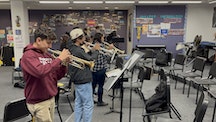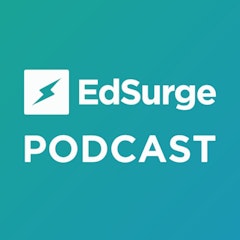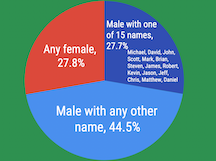
In our increasingly digital world, educators recognize the significance of integrating AI tools in the classroom. AI integration can address diverse learning needs, promote data-driven decision-making, and spur class discussion. Leveraging AI in the classroom can enhance teaching while preparing students for a future where AI is integral to the workforce. It is essential for educators to tap into professional development (PD) opportunities to advance their understanding of how to use AI to improve the classroom experience.
ISTE U serves as a digital hub offering top-tier professional learning courses designed to assist educators in developing fundamental skills for teaching and learning in a digital world. Recently, EdSurge spoke with Chelsey McClelland, a third-year social studies teacher at Lawrence North High School in Indianapolis who recently completed the ISTE U course Artificial Intelligence Explorations for Educators.
EdSurge: Why did you decide to take the ISTE U AI course? What were your goals?
McClelland: One of the things that piqued my interest in the ISTE U course was that I didn’t know much about using AI. I knew of ChatGPT from reading articles online, but I didn’t know how it worked. I was just worried that my students would use this to write all their essays! And at first, our school blocked its use. I think all educators grew concerned.
I was at a crossroads; I didn’t want students to use it because I didn’t want academic dishonesty, but I also knew this technology would not go away. I thought it was really important to take the course because if I don’t learn how to use it effectively and I don’t learn what it is, then I won’t be able to convey that to students. I’m doing them a disservice if I don’t learn about AI.
What elements of the course structure and content were particularly effective in facilitating your learning about AI?
The instructor was really supportive. The course seemed more focused on my outcomes — on my learning and applying the material — rather than meeting a deadline. I loved that the course was asynchronous and self-paced. As much as I love being a part of live PDs and collaborating with other educators across the country, it’s really hard to do that weekly.
In the ISTE U course, we could regularly chat with classmates through posts and replies. I could still connect with educators but without having to be on a , especially considering different time zones and start dates for school. My school started in early July, so I finished the course during the first few weeks of my school year. I appreciated having the flexibility to say, I’m super swamped this first week back at school and don’t have time in the evenings; I’m just going to sit down and do this on Sunday when I’m doing my lesson planning.
I really loved that every module opened with a fun way that AI can be used — it’s not just ChatGPT writing an essay or MagicSchool AI making your lesson plan. One of my favorite activities was giving prompts to different generative art AI bots, resulting in completely different designs. Even the AI tools that are trained using the same information could still give unique results! This later became a great discussion point with my students.
Another great example from the course was a whole lesson on deepfakes, which involve creating audio or video of situations that never actually happened. Being a government teacher and teaching about political elections, I’m really excited to apply what I’ve learned in my classroom. This will help me educate students on spotting deepfakes and discussing the possible implications.
The crux of what I got from the course, which has helped me a lot in approaching AI and how to use it in the classroom, is that there are so many things to learn. As educators, we often think that it’s bad for students to use ChatGPT and that it’s going to lead to them not learning anything. But we can’t knock students for not knowing how to use it properly if we don’t know how to use it properly ourselves; we need to teach them in what context to use AI and how to do it in an academically honest way.
Can you share specific examples of how you integrated AI concepts or tools into your teaching practices as a result of taking this course?
I work in a school with an emerging multilingual population, and AI has been so beneficial in helping me scaffold resources to make them more accessible for my students. Especially in a social studies classroom where I’m working with a lot of primary sources, sometimes it’s hard to figure out how to break down that language so that English learners are still accessing the same content but not losing the academic vocabulary.
In government class the other day, we used AI to gather background information on past political parties. Once students understood the basic points, we then discussed how those parties may have merged into modern political parties.
I have also held class discussions about how AI works and how it is trained with information from the internet. This leads to conversations around what problems could arise. I ask students, “Could AI be trained on bad information? What can we do about that?” We discuss how we can’t blindly trust AI; rather, we can use it as a baseline to build knowledge. I think of it as levels of taxonomy: AI can give us a basic understanding, but then students need to analyze and create from there.
What advice can you offer other educators looking to learn more about integrating AI in their classrooms?
Don’t be afraid of AI. It seems like there exists this fear that AI will replace teachers. AI can teach kids content, but it doesn’t teach them how to apply it. That’s our job as teachers. Our role is changing a bit, but for the better. Now, we don’t necessarily need to spend as much time teaching the baseline information. Instead, we can do more projects, engage in more class discussions, and help students apply that information.
I encourage teachers to find their online communities. I follow several edtech accounts that offer ideas on using AI in the classroom, and I adjust the ideas to my different classes. This doesn’t mean redoing everything in your lessons. Try revising a couple of lessons for each unit by integrating AI tools. You don’t have to totally change what you are doing to expose students to AI.
AI is going to become a more integral part of the workforce. If we as educators are trying to prepare students for the world of college and careers, we must train them to use AI tools responsibly.
ISTE U’s Artificial Intelligence Explorations for Educators course is offered each spring, summer and fall. Private cohorts are available for cohorts of 20 or more educators. Learn more at iste.org/AIcourse or reach out to isteu@iste.org for more information.
- SEO Powered Content & PR Distribution. Get Amplified Today.
- PlatoData.Network Vertical Generative Ai. Empower Yourself. Access Here.
- PlatoAiStream. Web3 Intelligence. Knowledge Amplified. Access Here.
- PlatoESG. Carbon, CleanTech, Energy, Environment, Solar, Waste Management. Access Here.
- PlatoHealth. Biotech and Clinical Trials Intelligence. Access Here.
- Source: https://www.edsurge.com/news/2023-11-01-how-can-teachers-prepare-students-for-an-ai-driven-future
- :has
- :is
- :not
- :where
- 20
- a
- Able
- About
- academic
- accessible
- accessing
- Accounts
- across
- activities
- actually
- adjust
- advance
- advice
- afraid
- AI
- AI bots
- AI Integration
- All
- also
- an
- analyze
- and
- anything
- Apply
- Applying
- appreciated
- approaching
- ARE
- arise
- around
- Art
- articles
- artificial
- artificial intelligence
- AS
- ask
- assist
- At
- audio
- available
- away
- back
- background
- Bad
- Baseline
- basic
- BE
- became
- because
- become
- been
- being
- beneficial
- Better
- Bit
- blindly
- blocked
- bots
- Break
- build
- but
- by
- call
- CAN
- careers
- change
- changing
- ChatGPT
- class
- classes
- classroom
- collaborating
- College
- Communities
- Completed
- completely
- concepts
- concerned
- Conference
- Connect
- considering
- content
- context
- conversations
- could
- country
- Couple
- course
- courses
- create
- Creating
- Crossroads
- crux
- data-driven
- Dates
- day
- deadline
- decide
- deepfakes
- designed
- designs
- developing
- Development
- DID
- didn
- different
- digital
- digital world
- discuss
- discussed
- discussing
- discussion
- discussions
- diverse
- do
- Doesn’t
- doing
- don
- Dont
- down
- during
- each
- Early
- edtech
- educate
- educators
- Effective
- effectively
- Elections
- elements
- embedded
- emerging
- encourage
- engage
- English
- enhance
- especially
- ESSAY
- essential
- Even
- Every
- everything
- example
- examples
- excited
- exists
- experience
- facilitating
- Fall
- Favorite
- fear
- few
- Figure
- Find
- First
- Flexibility
- focused
- follow
- For
- from
- fun
- fundamental
- future
- gather
- generative
- Give
- Giving
- Go
- Goals
- going
- got
- Government
- great
- grew
- happened
- Hard
- Have
- having
- Held
- help
- helped
- helping
- High
- honest
- How
- How To
- HTTPS
- Hub
- i
- ideas
- if
- implications
- important
- improve
- in
- increasingly
- information
- instead
- integral
- integrated
- Integrating
- integration
- Intelligence
- interest
- Internet
- into
- involve
- IT
- ITS
- Job
- jpg
- July
- just
- kids
- Know
- Knowing
- knowledge
- language
- later
- lead
- Leads
- LEARN
- learned
- learners
- learning
- lesson
- Lessons
- levels
- leveraging
- like
- live
- looking
- losing
- Lot
- love
- loved
- make
- Making
- many
- material
- May..
- me
- mean
- meeting
- Modern
- module
- more
- much
- must
- my
- necessarily
- Need
- never
- news
- North
- now
- of
- offer
- offered
- offering
- often
- on
- once
- ONE
- online
- online communities
- opened
- opportunities
- or
- Other
- our
- ourselves
- out
- outcomes
- part
- particularly
- parties
- past
- PDS
- plan
- planning
- plato
- Plato Data Intelligence
- PlatoData
- Point
- points
- political
- political parties
- population
- possible
- Posts
- practices
- Prepare
- preparing
- primary
- private
- problems
- professional
- projects
- properly
- rather
- reach
- Reading
- really
- recently
- recognize
- regularly
- replace
- Resources
- responsibly
- result
- resulting
- Role
- s
- same
- say
- School
- seemed
- seems
- serves
- several
- Share
- significance
- sit
- situations
- skills
- So
- Social
- sometimes
- Sources
- specific
- spend
- spotting
- spring
- start
- started
- Still
- structure
- Students
- studies
- summer
- sunday
- Super
- supportive
- T
- Take
- taking
- Tap
- taxonomy
- teacher
- teachers
- Teaching
- Technology
- than
- that
- The
- the world
- their
- Them
- then
- There.
- things
- Think
- this
- those
- thought
- Through
- time
- to
- tools
- TOTALLY
- Train
- trained
- true
- Trust
- try
- trying
- understanding
- understood
- unique
- unit
- us
- use
- used
- using
- Video
- video conference
- want
- was
- Way..
- we
- week
- weekly
- Weeks
- were
- What
- when
- which
- while
- WHO
- whole
- why
- will
- with
- without
- Won
- Work
- worked
- Workforce
- working
- works
- world
- worried
- would
- write
- writing
- year
- you
- Your
- youtube
- zephyrnet
- zones












